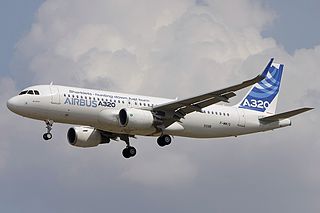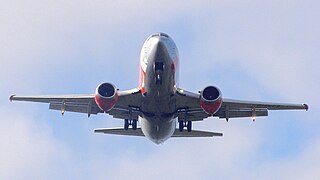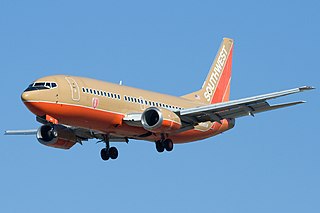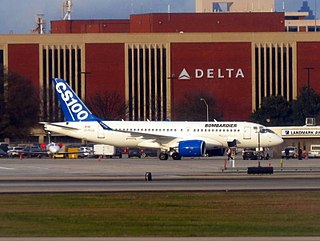Bombardier Aviation is a division of Bombardier Inc. It is headquartered in Dorval, Quebec, Canada. Its most popular aircraft included the Dash 8 Series 400, CRJ100/200/440, and CRJ700/900/1000 lines of regional airliners, and the newer CSeries. It also manufactured the Bombardier 415 amphibious water-bomber, and currently makes the Global Express and the Challenger lines of business jets.

The Boeing 737 is an American narrow-body airliner produced by Boeing at its Renton factory in Washington. Developed to supplement the Boeing 727 on short and thin routes, the twinjet retained the 707 fuselage width and six abreast seating but with two underwing turbofans instead of four. Envisioned in 1964, the initial 737-100 made its first flight in April 1967 and entered service in February 1968 with Lufthansa. The lengthened 737-200 entered service in April 1968, and evolved through four generations, offering several variants for 85 to 215 passengers.

The Airbus A319 is a member of the Airbus A320 family of short- to medium-range, narrow-body, commercial passenger twin-engine jet airliners manufactured by Airbus. The A319 carries 124 to 156 passengers and has a maximum range of 3,700 nmi. Final assembly of the aircraft takes place in Hamburg, Germany and Tianjin, China.

The Airbus A320 family is a series of narrow-body airliners developed and produced by Airbus. The A320 was launched in March 1984, first flew on 22 February 1987, and was introduced in April 1988 by Air France. The first member of the family was followed by the longer A321, the shorter A319, and the even shorter A318 . Final assembly takes place in Toulouse in France; Hamburg in Germany; Tianjin in China since 2009; and Mobile, Alabama in the United States since April 2016.

The Airbus A321 is a member of the Airbus A320 family of short to medium range, narrow-body, commercial passenger twin engine jet airliners; it carries 185 to 236 passengers. It has a stretched fuselage which was the first derivative of the baseline A320 and entered service in 1994, about six years after the original A320. The aircraft shares a common type rating with all other Airbus A320-family variants, allowing A320-family pilots to fly the aircraft without the need for further training.

A jet airliner or jetliner is an airliner powered by jet engines. Airliners usually have two or four jet engines; three-engined designs were popular in the 1970s but are less common today. Airliners are commonly classified as either the large wide-body aircraft, medium narrow-body aircraft and smaller regional jet.

The Airbus A318 is the smallest and least numerous variant airliner of the Airbus A320 family. The A318 carries 107 to 132 passengers and has a maximum range of 5,750 kilometres. Final assembly of the aircraft took place in Hamburg, Germany. It is intended primarily for short-range service.

Cruise is the phase of aircraft flight that starts when the aircraft levels off after a climb, until it begins to descend for landing. Cruising usually comprises the majority of a flight, and may include small changes in heading, airspeed, and altitude.

The Boeing 7J7 was an American short- to medium-range airliner proposed by American aircraft manufacturer Boeing in the 1980s. It would have carried 150 passengers and was touted as the successor to the successful Boeing 727. It was initially planned to enter service in 1992. This was intended as a highly fuel-efficient aircraft employing new technologies, but it was postponed indefinitely as the price of oil dropped during the 1980s.

The Airbus A220 is a family of five-abreast narrow-body airliners by Airbus Canada Limited Partnership (ACLP). It was originally developed by Bombardier and had two years in service as the Bombardier CSeries. The program was launched on 13 July 2008. The smaller A220-100 made its maiden flight on 16 September 2013, received an initial type certificate from Transport Canada on 18 December 2015, and entered service on 15 July 2016 with launch operator Swiss Global Air Lines. The longer A220-300 first flew on 27 February 2015, received an initial type certificate on 11 July 2016, and entered service with airBaltic on 14 December 2016.

A twinjet or twin-engine jet is a jet aircraft powered by two engines. A twinjet is able to fly well enough to land with a single working engine, making it safer than a single-engine aircraft in the event of failure of an engine. Fuel efficiency of a twinjet is better than that of aircraft with more engines. These considerations have led to the widespread use of aircraft of all types with twin engines, including airliners, fixed-wing military aircraft, and others.

A narrow-body aircraft or single-aisle aircraft is an airliner arranged along a single aisle, permitting up to 6-abreast seating in a cabin less than 4 metres (13 ft) in width. In contrast, a wide-body aircraft is a larger airliner usually configured with multiple aisles and a fuselage diameter of more than 5 metres (16 ft), allowing at least seven-abreast seating and often more travel classes.

The competition between Airbus and Boeing has been characterized as a duopoly in the large jet airliner market since the 1990s.

The Boeing 737 Classic is a series of narrow-body airliners produced by Boeing Commercial Airplanes, the second generation of the Boeing 737 series of aircraft. Development began in 1979 and the first variant, the 737-300, first flew in February 1984 and entered service that December. The stretched 737-400 first flew in February 1988 and entered service later that year. The shortest variant, the 737-500, first flew in June 1989 and entered service in 1990.

The Boeing 737 Next Generation, commonly abbreviated as 737NG, or 737 Next Gen, is a twin-engine narrow-body aircraft produced by Boeing Commercial Airplanes. Launched in 1993 as the third generation derivative of the Boeing 737, it has been produced since 1997.

The Airbus A320neo family is an incremental development of the A320 family of narrow-body airliners produced by Airbus. The A320neo family is based on the previous A319, A320, and A321, which was then retrospectively renamed the A320ceo family.

The middle of the market, often abbreviated MoM, is the airliner market between the narrowbody and the widebody aircraft, a market segmentation used by Boeing Commercial Airplanes since at least 2003. Both Airbus and Boeing produce aircraft that serve this segment.

On 28 April 2016, Bombardier Aerospace, a division of Bombardier Inc., recorded a firm order from Delta Air Lines for 75 CSeries CS100s plus 50 options. On 27 April 2017, The Boeing Company filed a petition for dumping them at $19.6m each, below their $33.2m production cost. On the same day, both Bombardier and the government of Canada rejected Boeing's claim, vowing to mount a "vigorous defence".
This is a list of aviation-related events in 2018.
















